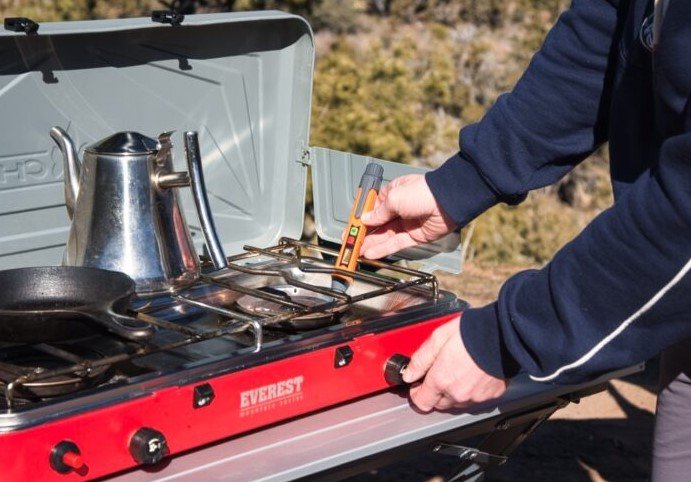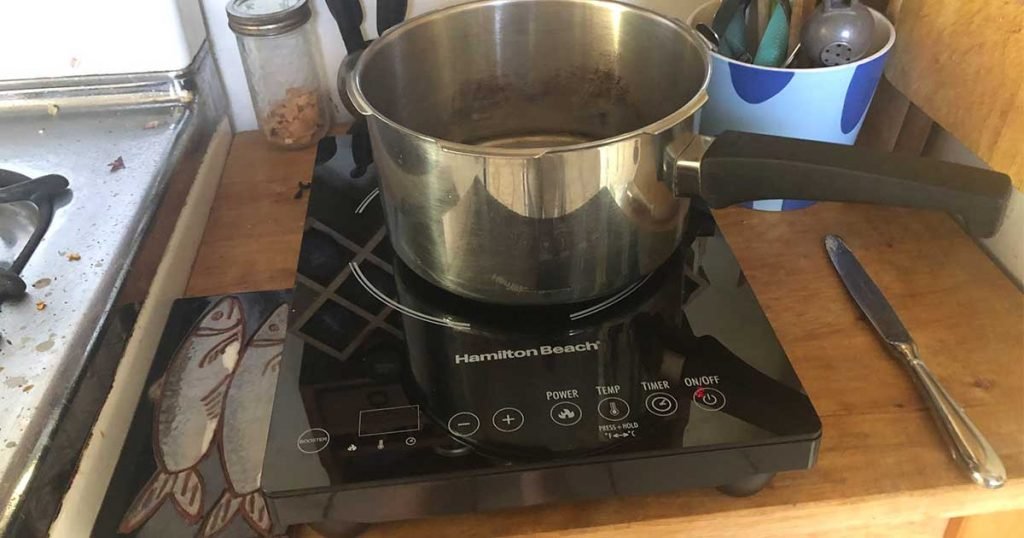As a fellow cooking enthusiast, I know you depend on your gas stove daily to whip up some nice meals. But gas appliances always carry some risk of leaks, which can lead to dangerous levels of carbon monoxide and even explosions if undetected.
In fact, the US recorded more than 2,600 gas pipeline leaks and explosions in 2010 and 2021 alone. The incidents resulted in more than 600 injuries and 122 deaths, not to mention billions in property damages. That’s why having the right gas leak detector in your home is so important.
Best Gas Range Leak Detectors in 2023
We’ll walk through some of the top gas detectors according to our experience and research, as well as the key types of leak detectors, must-have features, proper placement, and what to do if your alarm does go off. Safety first, so let’s get to it.
1. FIRST ALERT Combination Explosive Gas Alarm
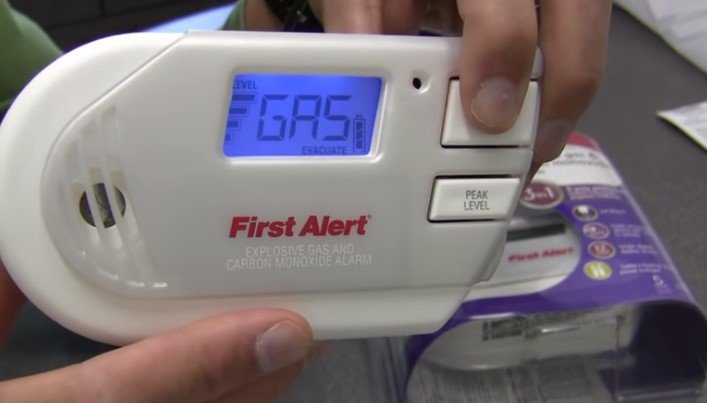
I bet you take safety seriously, and detecting potential gas leaks and carbon monoxide is no joke to you. The First Alert GCO1CN alarm tops my list for offering reliable protection. This handy little device can cover most homes with its advanced dual-sensor technology. The digital readout and loud dual alarms ensure you’ll be alerted to any threats quickly, so you can respond and get repairs taken care of.
The detector gives you professional-grade gas and CO detection at a reasonable price point. Given the peace of mind this thing delivers, I’d say it’s a worthy investment for home safety.
Let’s get into some pros and cons, so you can decide if it’s a fit for your space.
Pros – What I Liked
- Has both infrared methane gas and electrochemical CO sensors for comprehensive alert capabilities. This thing means business!
- Digital display shows current CO levels and methane readings right on the unit. Super handy.
- Loud 85-decibel alarm works even if you’re in deep sleep (or jamming too hard to your playlists).
- Bright red LEDs also indicate threats, which could be helpful if hard of hearing.
- Pre-calibrated and easy installation with included screws and peel/stick adhesive. Get it up and running fast.
- Runs on two AA batteries or plugs in for constant power. I like having options!
- Five-year limited warranty provides decent protection.
Cons – What I Didn’t Like
- Doesn’t have smart connectivity to send mobile alerts, which would be nice for extra peace of mind when away.
- CO sensors may require more frequent replacement than some other detectors. Plan on swapping it out every 5-7 years.
- No mute option on alarms could be annoying when doing routine propane work, etc around the house.
2. TopTess Natural Gas Detector
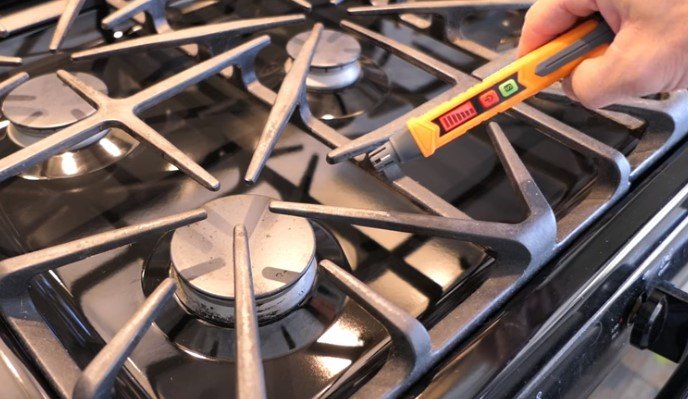
For the price, the TopTes PT177 gives you excellent natural gas detection in an easy-to-use package. The loud dual alarms ensure you’re alerted quickly to take cautionary steps. While not the fanciest design, it’s an affordable gas sniffer that can provide vital protection for any home.
It uses dual semiconductor sensors to detect combustible gas leaks down to 1 ppm methane concentrations. Impressive sensitivity!
Pros – What I Liked
- Loud 85-decibel audible alarm makes it hard to miss high readings. Helpful flashing red LEDs provide visual alerts too.
- Easy one-button operation and intuitive displays – just power it on and it starts continuously monitoring air.
- Handy portable design lets you scan all over for possible leak sources. Sniff those pipes!
- Low battery indicator reminds you to swap the 2x AAAs when needed. Don’t run out of juice mid-inspection!
Cons – What I Didn’t Like
- Requires holding down button continuously to take readings, which could get tiresome. An auto-monitoring mode would be nice.
- Detection range is only 10-20 feet. Larger spaces require walking around to cover fully.
3. Airthings 2960 View Plus

You can Breathe Easy with the Airthings 2960 View Plus Monitor, and I will tell you why. With six sensors built in, it tracks radon, particulates, CO2, VOCs, temperature, and humidity – basically all the air quality basics. The gadget delivers superb air quality detection and peace of mind in your kitchen. Just being able to easily keep tabs on all the airborne factors that impact health and comfort makes this little gadget a win in my book!
If you want to stay on top of your home’s indoor environment, here are my thoughts on the Airthings 2960:
Pros – What I Liked
- Provides continuous tracking of radon, which is awesome since high levels are invisible and odorless. This thing keeps me informed.
- Clear, easy-to-understand readings on the integrated display. I can check current air quality with a quick glance.
- Sends instant mobile alerts if thresholds are exceeded. So handy when I’m not home!
- Long battery life up to 2 years. One less thing to worry about maintaining.
- Small footprint blends right in. I have it in my living room displaying the current temperature.
- Data integration with Airthings dashboard is excellent for monitoring air quality trends over time.
Cons – What I Didn’t Like
- It’s on the pricier side, retailing around $220. But I suppose solid monitoring tech costs money.
- No display backlight makes it tough to read in darker rooms.
4. Bixtek Natural Gas Leak Detector for Home
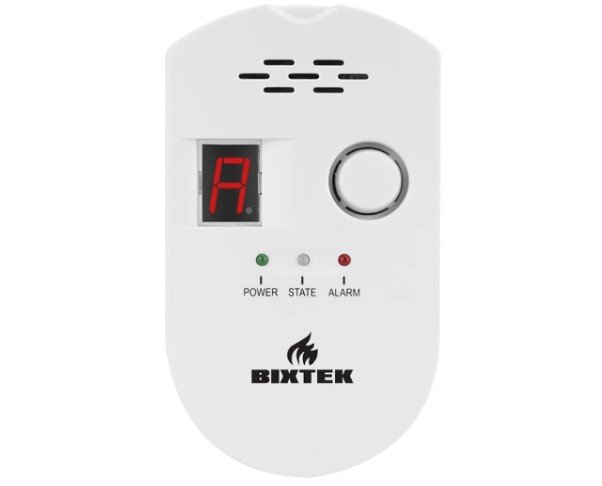
For an affordable price, the Bixtek natural gas alarm provides quality gas leak detection. The loud audio/visual alerts give you prompt warning to address hazardous gas accumulation in your kitchen. It uses an infrared sensor to continuously sniff for combustible gas leaks down to 10 ppm concentrations. Sensitive enough for peace of mind.
If you need basic, reliable gas monitoring without breaking the bank, this is a solid choice.
Pros – What I Liked
- Loud 85dB alarm paired with a bright flashing light ensures you’re notified of any dangerous gas accumulation. Hard to miss.
- Simple plug-in installation. I had it up and running in minutes with the included outlet adapter. Super easy.
- Lower cost retailing around $35. An affordable workhorse that gets the job done on a budget.
- Lightweight and compact profile blends into any room.
Cons – What I Didn’t Like
- No battery backup, so it won’t detect leaks during power outages.
- Probably not as durable or heavy-duty as some pricier detectors.
- Only monitors the room it’s plugged into. Can’t scan the whole house for leak sources like a portable model.
5. Kidde Carbon Monoxide Detector
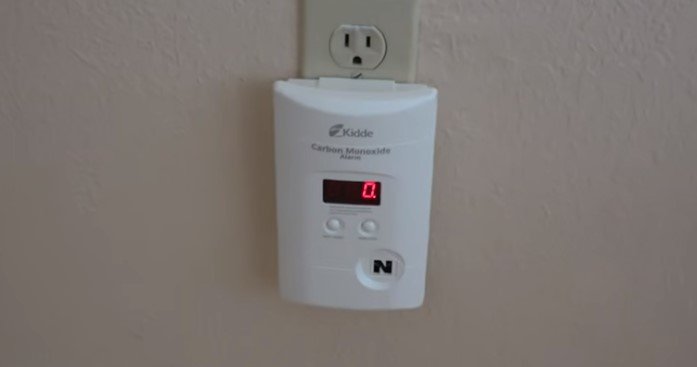
For comprehensive carbon monoxide monitoring, you can count on the Kidde digital detector. The backup battery, loud alarms, and long warranty make it well worth the investment for whole-home safety and awareness. The gadget features a digital readout that displays current CO levels in PPM right on the unit. It also has a loud 85dB alarm. It’s hard to sleep through if CO is detected.
Pros – What I Liked
- Loud alarm and flashing red lights so that you can easily hear and see the alerts
- Comes with a 9V battery pre-installed so it keeps detecting even with power loss.
- 7-year limited warranty provides excellent coverage you can rely on.
- Established, trusted brand with decades of experience in home safety devices.
Cons – What I Didn’t Like
- No smart alerts or connectivity. Mobile notifications would provide extra peace of mind.
- The electrochemical CO sensor needs replacement every 5-7 years to maintain accuracy.
- Wall mount only, so it can’t be used as a portable gadget to check other areas for CO issues
6. Techamor Y201 Gas Leak Detector
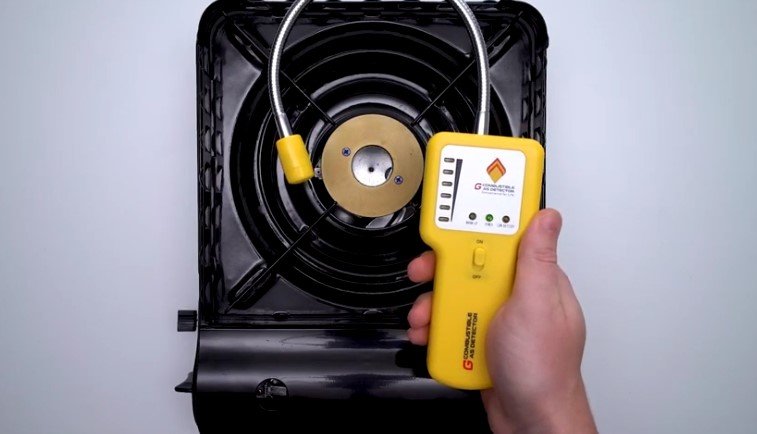
For an affordable and portable way to detect combustible gas leaks, the Techamor Y201 gas sniffer is a solid choice you might want to consider. It uses semiconductor sensors to sniff out natural gas, propane, methane, and more.
While it lacks some of the perks and robustness of pricier detectors, the Techamor Y201 can detect gas concentrations down to 1 ppm, thanks to its dual sensors. Impressive sensitivity!
Here are my thoughts about it:
Pros – What I Liked
- Loud audible alarm paired with a bright flashing LED makes it hard to miss high readings.
- Super lightweight and compact, almost palm-sized. Convenient for scanning all over for leaks.
- Simple one-button operation – just power on and it starts continuous monitoring. Easy to use.
- Budget-friendly at around $25. A very affordable detector option.
Cons – What I Didn’t Like
- Durability and longevity seem questionable for heavy long-term use.
- Eats through batteries quickly if used continuously. I found myself replacing the AAAs often.
- Short 10-15 foot detection range. Larger areas take more sweeping to monitor fully.
Honorable Mentions – Other Top Gas Detectors
You love my picks, right? Well, I have a few more that I thought would be great fits as well. Check out the options below that you can also consider:
Choosing the Best Gas Leak Detector – Buying Guide
Picking the right gas leak detector for your home requires considering a few key factors:
1. Detection Method
The two main technologies are combustible gas sensors and infrared laser methane detectors. Combustible sensors use metal oxide or semiconductor materials to detect raw natural gas, propane, and other fuel gases. They are affordable, but can sometimes false alarm from non-hazardous fumes. Infrared laser detectors, on the other hand, are much more precise at sniffing out methane leaks specifically, using laser diode light and spectroscopy. Almost no false alarms, but more expensive.
2. Coverage Area
Determine how much space you need your detector to cover. Basic models monitor around 1,000 sq ft. For larger homes, you’ll need multiple detectors or whole-house systems with wireless interconnectivity and remote sensors. Make sure the coverage range suits your square footage.
3. Power Source
Gas leak detectors run on either disposable batteries or plug-in to home electricity. Battery-powered models offer portability for leak checking all over, while hardwired options provide constant monitoring without changing batteries. Both work reliably. Hardwired detectors may also have battery backups in case of outages.
4. Alert Type
An effective gas detector needs to actually get your attention, so loud audio alarms in the range of 80-85 decibels are ideal. Visual alerts like flashing LED lights also help, especially for those who are hearing impaired.
5. Smart Features
Smart leak detectors take safety up a notch by connecting to WiFi and your smartphone to provide push notifications if a leak is detected. This allows you to respond even when away from home. Nice to have, if not essential.
Types of Gas Stove Leak Detectors
Gas stove detectors come in two main types:
Combustible Gas (Methane) Detectors
Combustible gas detectors contain sensors made from materials like metal oxide or semiconductor compounds that react in the presence of methane, propane, and other burnable gases. This allows them to detect leaks down to 20-100 ppm typically.
While affordable, they can also react to false alarms from other volatile fumes that are not necessarily hazardous. Placement is also important – combustible detectors need to be installed close to leak sources at floor level for best performance.
Infrared Laser Methane Detectors
Infrared laser methane detectors take a more advanced approach. They use a laser diode to emit a specific light wavelength. This allows them to “sniff out” methane leaks down to 1 ppm with incredibly high accuracy. You won’t expect any false alarms here.
Infrared models can be installed at any height and work in living spaces and bedrooms, unlike combustible detectors. However, the laser technology makes them around 2-3x more expensive than basic sensors. But for whole kitchen (and home) protection, infrared laser methane detectors are worth the extra investment.
What Are Possible Reasons for Your Gas Stove Leaking?
According to the EPA, 1 in every 4 homes has gas leak issues. While gas ranges are generally very safe, wear and tear over time can lead to dangerous leaks. Some common culprits include:
- Cracked or damaged gas lines
- Loose line connections
- Faulty valves, seals, or regulator
- Clogged burner ports
- Corroded pipes or appliances
- Improper appliance installation
- Excess pressure/incomplete combustion
What to Do if You Detect a Gas Leak at Home
Gas explosion claims 500 lives per year on average. Don’t take risks with gas safety! If your gas alarm goes off, don’t panic. Follow the following steps and you’ll be safe:
- Evacuate the home immediately and call 911 once outside.
- Do NOT turn any lights or appliances on/off or use phones inside. Any spark could cause an explosion.
- If possible, turn off the main gas supply valve outside.
- Have technicians inspect all gas lines and appliances for the leak source before using them again.
- Install carbon monoxide detectors as well to fully protect your family.
The Bottom Line
Having trusted gas leak detectors strategically placed provides you some peace of mind. I recommend going for smart, laser-based alarms with mobile connectivity for the most sensitive leak detection. Look for those with loud audio/visual alerts that actually get your attention, even at night. With the right detectors watching over your home’s gas appliances, you can relax and enjoy cooking securely.
Stay safe!
Common Questions
What should I look for in a gas leak detector?
Look for detectors with sensitive methane and natural gas sensors, loud audio/visual alerts, clear displays, long battery life, and smart detection capabilities. Also, consider the coverage range and whether portable or stationary models work best.
What detection technology is best?
Infrared laser methane detectors offer the most accurate leak detection, while semiconductor or metal oxide sensors are affordable but can false alarm. Dual sensor models combine both for comprehensive sensing.
How do I properly place gas leak detectors?
Install next to potential leak sources like stoves, water heaters, and furnaces. Having one on every level of the home provides the best coverage. Follow manufacturer guidance.
When should the detectors be replaced?
Replace sensors every 5-7 years per manufacturer specifications to maintain accuracy. Look for models with easy sensor replacement. Also, swap batteries regularly.
